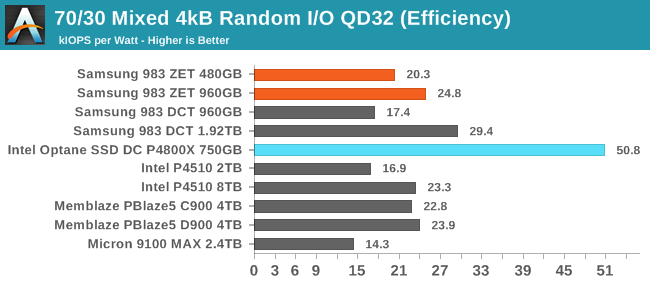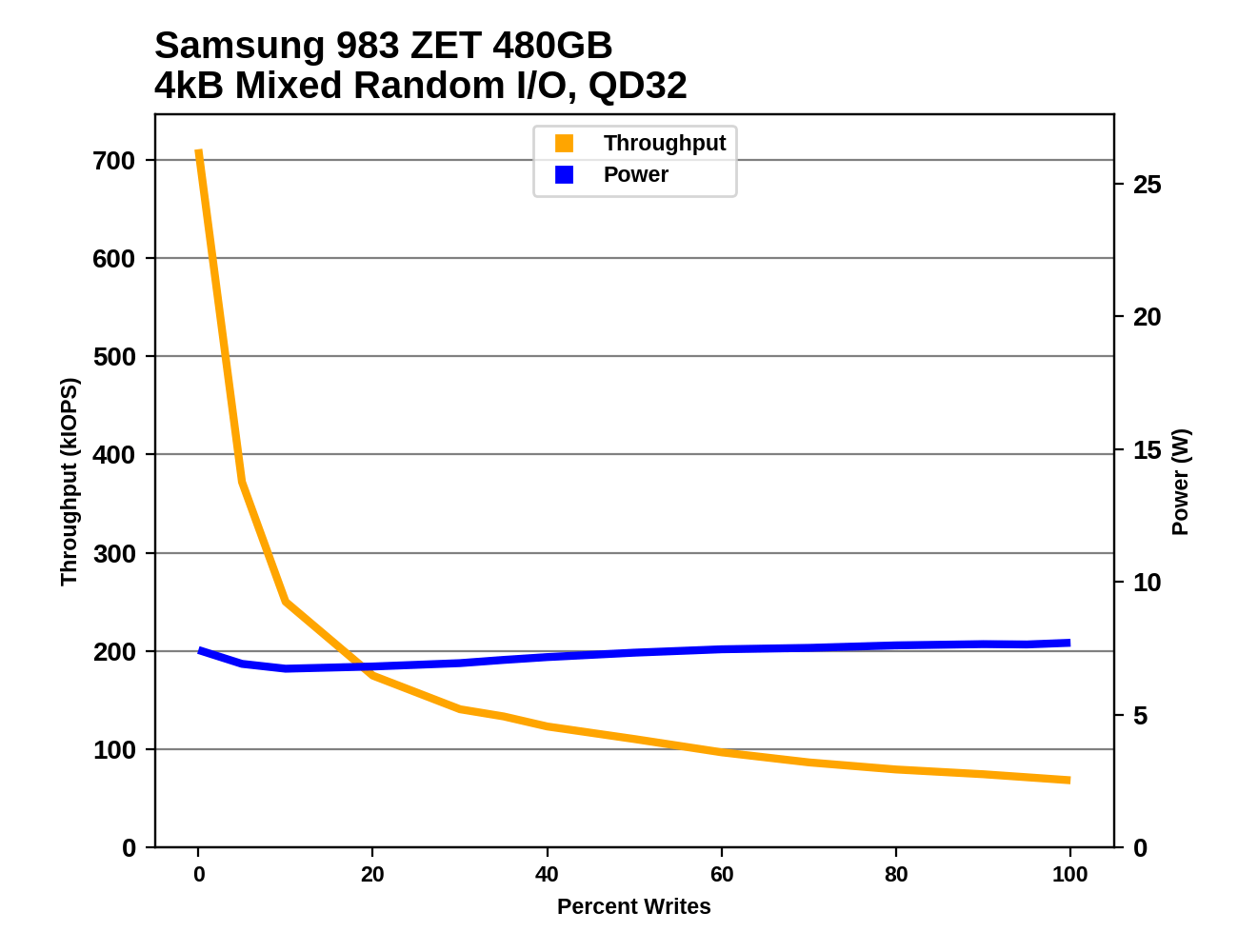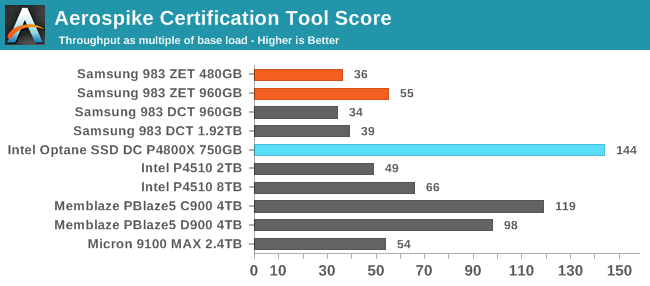The Samsung 983 ZET (Z-NAND) SSD Review: How Fast Can Flash Memory Get?
by Billy Tallis on February 19, 2019 8:00 AM ESTMixed Random Performance
Real-world storage workloads usually aren't pure reads or writes but a mix of both. It is completely impractical to test and graph the full range of possible mixed I/O workloads—varying the proportion of reads vs writes, sequential vs random and differing block sizes leads to far too many configurations. Instead, we're going to focus on just a few scenarios that are most commonly referred to by vendors, when they provide a mixed I/O performance specification at all. We tested a range of 4kB random read/write mixes at queue depths of 32 and 128. This gives us a good picture of the maximum throughput these drives can sustain for mixed random I/O, but in many cases the queue depth will be far higher than necessary, so we can't draw meaningful conclusions about latency from this test. As with our tests of pure random reads or writes, we are using 32 (or 128) threads each issuing one read or write request at a time. This spreads the work over many CPU cores, and for NVMe drives it also spreads the I/O across the drive's several queues.
The full range of read/write mixes is graphed below, but we'll primarily focus on the 70% read, 30% write case that is a fairly common stand-in for moderately read-heavy mixed workloads.
 |
|||||||||
| Queue Depth 32 | Queue Depth 128 | ||||||||
On the 70/30 mixed random IO tests, the Samsung 983 ZET provides similar performance to a TLC-based 983 DCT of twice the capacity. This leaves both Samsung drives as among the slowest drives in this batch, because the other flash-based drives are mostly higher-capacity models using controllers with higher channel counts than the Samsung Phoenix. The Samsung drives perform about the same at QD128 as at QD32, while some of the larger drives take advantage of the higher queue depth to almost catch up to the Intel Optane SSD.
 |
|||||||||
| QD32 Power Efficiency in MB/s/W | QD32 Average Power in W | ||||||||
| QD128 Power Efficiency in MB/s/W | QD128 Average Power in W | ||||||||
The TLC-based 1.92TB 983 DCT uses the least power on these mixed IO tests and it ends up with some of the best efficiency scores among the flash-based SSDs, about 60% of the performance per Watt that the Intel Optane SSD provides. The two 983 ZET drives use a bit more power than the 983 DCT, so they end up with fairly ordinary efficiency scores that are outclassed by the largest TLC drives in the QD128 test.
 |
|||||||||
| QD32 | |||||||||
| QD128 | |||||||||
The Samsung 983 ZET starts off the mixed IO tests with extremely high random read performance, but the performance drops very steeply as writes are added to the mix—just 5% writes is enough to almost cut total throughput in half, and the advantage of Z-NAND is gone by the time the workload is 20% writes. Except on the most read-heavy workloads, the flash-based SSDs are limited largely by their steady-state write performance, and the 983 ZET is handicapped there by its low overall capacities.
Aerospike Certification Tool
Aerospike is a high-performance NoSQL database designed for use with solid state storage. The developers of Aerospike provide the Aerospike Certification Tool (ACT), a benchmark that emulates the typical storage workload generated by the Aerospike database. This workload consists of a mix of large-block 128kB reads and writes, and small 1.5kB reads. When the ACT was initially released back in the early days of SATA SSDs, the baseline workload was defined to consist of 2000 reads per second and 1000 writes per second. A drive is considered to pass the test if it meets the following latency criteria:
- fewer than 5% of transactions exceed 1ms
- fewer than 1% of transactions exceed 8ms
- fewer than 0.1% of transactions exceed 64ms
Drives can be scored based on the highest throughput they can sustain while satisfying the latency QoS requirements. Scores are normalized relative to the baseline 1x workload, so a score of 50 indicates 100,000 reads per second and 50,000 writes per second. Since this test uses fixed IO rates, the queue depths experienced by each drive will depend on their latency, and can fluctuate during the test run if the drive slows down temporarily for a garbage collection cycle. The test will give up early if it detects the queue depths growing excessively, or if the large block IO threads can't keep up with the random reads.
We used the default settings for queue and thread counts and did not manually constrain the benchmark to a single NUMA node, so this test produced a total of 64 threads scheduled across all 72 virtual (36 physical) cores.
The usual runtime for ACT is 24 hours, which makes determining a drive's throughput limit a long process. For fast NVMe SSDs, this is far longer than necessary for drives to reach steady-state. In order to find the maximum rate at which a drive can pass the test, we start at an unsustainably high rate (at least 150x) and incrementally reduce the rate until the test can run for a full hour, and then decrease the rate further if necessary to get the drive under the latency limits.

The Samsung 983 ZET outscores its TLC-based sibling 983 DCT, but doesn't beat the throughput that the larger TLC drives provide. There's enough write activity in this test to seriously limit the performance of the Z-SSDs, and so the drives with higher channel counts and much more capacity overall can pull ahead. The Intel Optane SSD DC P4800X still provides the best score on this test, 2.6 times that of the larger 983 ZET and 21% faster than the fastest flash-based SSD we have on hand.
 |
|||||||||
| Power Efficiency | Average Power in W | ||||||||
The 983 ZET and 983 DCT have similar power consumption during this test, and both use substantially less power than the other SSDs in this batch. That doesn't translate to any big advantage in power efficiency, though the larger 983 ZET does provide the second-best efficiency score among the flash-based SSDs. The Optane SSD provides 50% better performance per Watt than any of the flash-based SSDs.










44 Comments
View All Comments